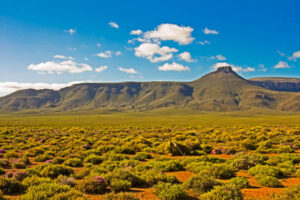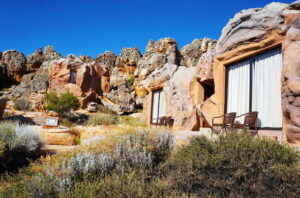
- Profile
- Tour Operators
- Accommodation
- prev
- next
Overview
Named after the Tankwa River that runs through the park as the main water provider in an otherwise semi-desert area, the Park was proclaimed in 1986. Since then, high biodiversity land has been added by SANParks to increase the conservation area from the original 27,064 ha to nearly 146,373 ha in early 2014.
Lying between the Cederberg Mountains and the Great Karoo escarpment, it incorporates three distinct ecosystems - pure desert in the west, open grasslands in the centre and the Roggeveld Mountains in the east. The Roggeveld range is the start of the escarpment and a vital contributor to the park's water supply. The true meaning of the word "Tankwa" is unknown, but it is said to be "Turbid water", "Place of the San" or "Thirst land", all of which fits this arid yet picturesque park so well.
The veld had been severely degraded by livestock overgrazing, and for the first few years it was not open to the public. Humans have lived in the region for at least 10 000 years - first the Bushmen and then the Khoe pastoralists, who moved their livestock with the migration of the wild animals. Then, in the 1700s, the trekboer farmers started using the Tankwa to graze their dropper and merino sheep while moving from the summer heat of the Cederberg to the cooler temperatures on the Karoo escarpment.
Eventually, farmers settled there but the arid climate and poor soils meant that nomadic livestock grazing was not sustainable. Once Tankwa had been proclaimed as a National Park, various farms were bought and added to the conservation area, which today extends to about 146,373 ha. The park is situated within the Succulent Karoo biome, an area renowned for its rare and endemic plant species, rich birdlife, and landscapes and is one of the arid biodiversity hotspots in the world.
Location
-
Calvinia, Calvinia, Northern Cape 8190, South Africa
Vital Park Information
South Africa
1 436 km²
Tap Water. High-quality water is widely available in South Africa and drinking from taps is fine, except in rural and drought-struck areas.
South African rand
Intermediate Risk - anti-malarial drugs is advisable only for high risk people from October to May.
March, April, May, June, July, August, September, October
The duration and temperature of the growing season separates the Succulent Karoo from other biomes. The Tankwa Karoo (Region) is one of the most arid sections of the Karoo. Isohyets of mean annual rainfall (mm) for the Karoo indicate that the Tankwa-Karoo National Park falls into the 0-100mm range (Venter et al. 1986), with 25% of the mean annual precipitation in summer. In contrast, the higher lying regions within the Roggeveld Escarpment, receive up to five times more rain annually.





